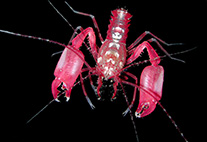Abstract
Three new and one known species of the genus Aporcelaimellus, collected mainly in natural areas from the Iberian Peninsula and characterized by having a simple uterus and atypical caudal region are described and illustrated, including line drawings, LM pictures and/or SEM pictures. Aporcelaimellus deserticola sp. n. is distinguished by its body 1.79–2.43 mm long, lip region 14–16 μm broad and offset by expansion rather than by constriction, odontostyle 18–21 μm long, neck 464–555 μm long, pharyngeal expansion 234–283 μm long or 49–52% of total neck length, a dorsal cell mass present at level of anterior end of intestine, uterus 34–67 μm long or 0.6–1.1 times the corresponding body diameter, V = 49–55, tail conical with rounded terminus (29–43 μm, c = 47–66, c’ = 0.9–1.4) and bearing a short but perceptible hyaline portion, and male unknown. Aporcelaimellus hyalinus sp. n. is characterized by its body 1.49–2.23 mm long, lip region offset by constriction and 13–16 μm broad, odontostyle 14–16 μm long, neck 389–474 μm long, pharyngeal expansion 183–242 μm long or 45–53% of total neck length, uterus 44–106 μm long or 0.7–1.8 times the corresponding body diameter, V = 48–55, tail conical with rounded terminus (27–41 μm, c = 38–68, c’ = 1.0–1.4) and short inner core, spicules 56 μm long, and seven irregularly spaced ventromedian supplements. Aporcelaimellus rarus sp. n. is distinguished by its body 1.96–2.34 mm long, lip region offset by constriction and 14–16 μm broad, odontostyle 15–16 μm long, neck 411–518 μm long, pharyngeal expansion 196–270 μm long or 48–52% of total neck length, a dorsal cellular mass at a short distance behind the cardia, uterus 63–96 μm long or 0.8–1.5 times the corresponding body diameter, V = 51–56, female tail short and conical (28–40 μm, c = 50–74, c’ = 0.7–0.9) with rounded terminus and bearing a dorsal concavity at its posterior half, and males unknown. New data are provided for A. salicinus. A discussion of these atypical species is also provided.
References
Altherr, E. (1968) Nématodes de la nappe phréatique du réseau fluvial de la Saale (Thuringe) et psammiques du Lac Stechlin (Brandebourg du Nord). Limnologica, 6, 247–320.
Altherr, E. & Delamare-Deboutteville, C. (1972) Nématodes interstitiels des eaux douces des États-Unis d'Amérique (États de Washington, du Colorado et du Massachusetts) récoltés par Cl. Delamare Deboutteville. Annales de Spéléologie, 27, 683–760.
Álvarez-Ortega, S., Abolafia, J., Liébanas, G. & Peña-Santiago, R. (2012) Studies on the genus Aporcelaimellus Heyns, 1965 (Nematoda, Dorylaimida, Aporcelaimidae). Four new species with complex uterus from Southeastern Iberian Peninsula. Zootaxa, 3551, 1–24.
Álvarez-Ortega, S., Abolafia, J. & Peña-Santiago, R. (2013a) Studies on the genus Aporcelaimellus Heyns, 1965 (Nematoda, Dorylaimida, Aporcelaimidae). Four typical species with simple uterus from Southern Iberian Peninsula. Zootaxa, 3613, 36–60. http://dx.doi.org/10.11646/zootaxa.3613.1.2
Álvarez-Ortega, S. & Peña-Santiago, R. (2010) Studies on the genus Aporcelaimellus Heyns, 1965 (Dorylaimida: Aporcelaimidae) - Redescription of six species studied by Thorne in 1974. Journal of Nematode Morphology and Systematics, 13, 67–89.
Álvarez-Ortega, S. & Peña-Santiago, R. (2012) Studies on the genus Aporcelaimellus Heyns, 1965 (Dorylaimida, Aporcelaimidae). Morphological and molecular characterization of Iberian A. obtusicaudatus (Bastian, 1865) Altherr, 1968, with an updated diagnosis of the species. Journal of Nematode Morphology and Systematics, 15, 103–126.
Álvarez-Ortega, S., Subbotin, S.A. & Peña-Santiago, R. (2013b) Morphological and molecular study of Californian species of the genus Aporcelaimellus Heyns, 1965 (Dorylaimida, Aporcelaimidae). Nematology, 15, in press.
http://dx.doi.org/10.1163/15685411-00002691Álvarez-Ortega, S., Subbotin, S.A. & Peña-Santiago, R. (2013c) Morphological and molecular characterization of Californian species of the genus Metaporcelaimus Lordello, 1965 (Dorylaimida, Aporcelaimidae), with a new concept of the genus. Nematology, 15, 251–278.
http://dx.doi.org/10.1163/138855410X513213Andrássy, I. (1986) The genus Eudorylaimus Andrássy, 1959 and the present status of its species (Nematoda: Qudsianematidae). Opuscula Zoologica Budapestinensis, 22, 1–42.
Andrássy, I. (2002) Free-living nematodes from the Fertő-Hanság National Park, Hungary. In: Mahunka, S. (Ed.), The fauna of the Fertő-Hanság National Park, 21–97.
Baqri, Q.H. & Khera, S. (1975) Two new species of the genus Aporcelaimellus Heyns, 1965 with some remarks on the relationship of Aporcelaimellus with Eudorylaimus Andrássy, 1959 (Dorylaimoidea: Nematoda). Dr. B. S. Chauhan Commemorative Volume, 171–180.
Bastian, H.C. (1865) Monograph of the Anguillulidae, or free nematoids, marine, land and freshwater; with descriptions of 100 new species. Transactions of the Linnean Society of London-Zoology, 25, 73–184.
http://dx.doi.org/10.1111/j.1096-3642.1865.tb00179.xDe Ley, P., Loof, P.A.A. & Coomans, A. (1993) Terrestrial nematodes from the Galápagos Archipelago II: Redescription of Aporcelaimellus obtusicaudatus (Bastian, 1865) Altherr, 1968, with review of similar species and a nomenclature for the vagina in Dorylaimida (Nematoda). Bulletin de l'Institut Royal des Sciences Naturelles de Belgique, 63, 13–34.
Heyns, J. (1965) On the morphology and taxonomy of the Aporcelaimidae, a new family of dorylaimoid nematodes. Entomology Memoirs, Department of Agricultural Technical Services, Republic of South Africa, 10, 1–51.
Lordello, L.G.E. (1965) Contribuçao para o conhecimento dos nematóides brasileiros da família Dorylaimidae. Tese Escola Superior de Agricultura "Luiz de Queiroz", Piracicaba, Brasil. 69 pp.
Meyl, A.H. (1955) Freilebende Nematoden aus binnenländischen Salzbiotopen zwischen Braunschweig und Magdeburg. Archiv für Hydrobiologie, 50, 568–614.
Peña-Santiago, R. & Ciobanu, M. (2008) The genus Crassolabium Yeates, 1967 (Dorylaimida: Qudsianematidae): Diagnosis, list and compendium of species, and key to their identification. Russian Journal of Nematology, 16, 77–95.
Thorne, G. (1974) Nematodes of the Northern Great Plains. Part II. Dorylaimoidea in part (Nemata: Adenophorea). South Dakota State University Agriculture Experimental Station Technical Bulletin, 41, 120 pp.
Thorne, G. & Swanger, H.H. (1936) A monograph of the nematode genera Dorylaimus Dujardin, Aporcelaimus n. g., Dorylaimoides n. g. and Pungentus n. g. Capita Zoologica, 6, 1–223.
Tjepkema, J.P., Ferris, V.R. & Ferris, J.M. (1971) Review of the genus Aporcelaimellus Heyns, 1965 and six species groups of the genus Eudorylaimus Andrássy, 1959 (Nematoda: Dorylaimida). Purdue University Agricultural Experiment Station Research Bulletin, 882, 52 pp.
Tulaganov, A.T. (1949) [Plant parasitic and soil nematodes of Uzbekistan.] Izdatelstvo Akademii Nauk Uzbekistan SSR, Tashkent, 1–227. (In Russian.)
Yeates, G.W. (1967) Studies on nematodes from dune sands. 6. Dorylaimoidea. New Zealand Journal of Science, 10, 752–784.

